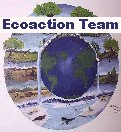ESTUARIES
Use the booklet A Guide To The Housatonic River Estuary to learn about Connecticut estuaries and how we affect them. You may mark the photocopy that you will keep and refer to the color booklet as needed, but please do not mark it.
Directions
1. Read through the following statements and questions. These are what you should know about estuaries. We will call these your learning objectives.
2. As you read the booklet, highlight or underline words or phrases to indicate where to find the information about the learning objectives. Remember: if you highlight more than five words in a paragraph, you are coloring, not highlighting.
3. Next to each area where you found information, write the objective number in the margin so you can find it later.
4. As you read the booklet, write the page number where you find information after the objective on this handout. This will help you find your highlighted areas later.
5. What you have created in this process is an index for the booklet so you can quickly find the information you need so you can now write a response under 10 of the objectives in your own words. If the objectives says you should know how something happens, write a response describing how it happens. If the objective is a statement of information, re-write it in your own words.
Learning Objectives
When you are finished, you should know:
 1. that estuaries are the tidal waters where rivers reach the
sea.
1. that estuaries are the tidal waters where rivers reach the
sea.
Page:
Your words:
2. that estuaries are the most diverse and productive zones for
life because of the energy and nutrients from the
combination of fresh water flows, tides, sea water
flows, and marine and fresh water deposition.
Page:
Your words:
3. how the production of organic matter in an estuary compares to other
ecosystems.
Page:
Your words:
4. the basic food web of an estuary, and how this is based on the physical
functioning of the estuary.
Page:
Your words:
5. what living organisms rely on estuary habitat and why.
Page:
Your words:
6. how estuaries support commercial fishing
Page:
Your words:
 7. what tidal wetlands and mud flats are, and their function in relation to pollution
and coastal protection from storm waves.
7. what tidal wetlands and mud flats are, and their function in relation to pollution
and coastal protection from storm waves.
Page:
Your words:
8. that because of their location, estuaries are prime areas for
development for homes, marinas, industrial sites and
shipping facilities, which destroy the natural
functioning of the estuary.
Page:
Your words:
9. how much estuary area has been lost because of various reasons.
Page:
Your words:
10. an outline of the history of human use of an example estuary area, and how
this history was influenced by the natural features of the estuary.
Page:
Your words:
 11. how estuary quality and tourism are interelated.
11. how estuary quality and tourism are interelated.
Page:
Your words:
12. how pollution of both fresh water and oceans will affect the
estuary.
Page:
Your words:
13. sources of pollution that affect estuary areas.
Page:
Your words:
14. how to protect estuaries from upland and shore area pollution.
Page:
Your words:
15. what has been done to protect and restore estuaries.
Page:
Your words:
16. what estuary is most directly affected by runoff from your neighborhood.
Page:
Your words:
17. where to get more information about estuaries.
Page:
Your words:
(Return to top of page)




 This page hosted by
This page hosted by  Get your own Free Home Page
Get your own Free Home Page
LSM EESci internet services provided by NetPlex. Many thanks.
Page address:

 Site Search
Site Search



 1. that estuaries are the tidal waters where rivers reach the
sea.
1. that estuaries are the tidal waters where rivers reach the
sea.
 7. what tidal wetlands and mud flats are, and their function in relation to pollution
and coastal protection from storm waves.
7. what tidal wetlands and mud flats are, and their function in relation to pollution
and coastal protection from storm waves.
 11. how estuary quality and tourism are interelated.
11. how estuary quality and tourism are interelated.